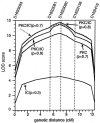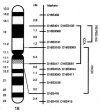Paroxysmal kinesigenic choreoathetosis locus maps to chromosome 16p11.2-q12.1
- PMID: 10577923
- PMCID: PMC1288380
- DOI: 10.1086/302682
Paroxysmal kinesigenic choreoathetosis locus maps to chromosome 16p11.2-q12.1
Abstract
Paroxysmal kinesigenic choreoathetosis (PKC), the most frequently described type of paroxysmal dyskinesia, is characterized by recurrent, brief attacks of involuntary movements induced by sudden voluntary movements. Some patients with PKC have a history of infantile afebrile convulsions with a favorable outcome. To localize the PKC locus, we performed genomewide linkage analysis on eight Japanese families with autosomal dominant PKC. Two-point linkage analysis provided a maximum LOD score of 10.27 (recombination fraction [theta] =.00; penetrance [p] =.7) at marker D16S3081, and a maximum multipoint LOD score for a subset of markers was calculated to be 11.51 (p = 0.8) at D16S3080. Haplotype analysis defined the disease locus within a region of approximately 12.4 cM between D16S3093 and D16S416. P1-derived artificial chromosome clones containing loci D16S3093 and D16S416 were mapped, by use of FISH, to 16p11.2 and 16q12.1, respectively. Thus, in the eight families studied, the chromosomal localization of the PKC critical region (PKCR) is 16p11.2-q12.1. The PKCR overlaps with a region responsible for "infantile convulsions and paroxysmal choreoathetosis" (MIM 602066), a recently recognized clinical entity with benign infantile convulsions and nonkinesigenic paroxysmal dyskinesias.
Figures




References
Electronic-Database Information
-
- Généthon, http://www.genethon.fr/ (for microsatellite markers and genetic distances between the marker loci)
-
- Human Genome Resources, http://www.ncbi.nlm.nih.gov/genome/guide/ (for radiation hybrid mapping information of ILR4 and ADCY7)
-
- Online Mendelian Inheritance in Man (OMIM), http://www.ncbi.nlm.nih.gov/Omim/ for PKC [MIM 128200], infantile convulsions and paroxysmal choreoathetosis [MIM 602066], PDC [MIM 118800], CSE [MIM 601042], ICCA [MIM 602066], ENFL1 [MIM 600513], ENFL2 [MIM 603204], IL4R [MIM 147781], ADCY7 [MIM 600385], PPP4C [MIM 602035], and STM [MIM 600641])
References
-
- Auburger G, Ratzlaff T, Lunkes A, Nelles HW, Leube B, Binkofski F, Kugel H, et al (1996) A gene for autosomal dominant paroxysmal choreoathetosis/spasticity (CSE) maps to the vicinity of a potassium channel gene cluster on chromosome 1p, probably within 2 cM between D1S443 and D1S197. Genomics 31:90–94 - PubMed
-
- Browne DL, Gancher ST, Nutt JG, Brunt ERP, Smith EA, Kramer P, et al (1994) Episodic ataxia/myokymia syndrome is associated with point mutations in the human potassium channel gene, KCNA1. Nat Genet 8:136–140 - PubMed
-
- Brunt ER, van Weerden TW (1990) Familial paroxysmal kinesigenic ataxia and continuous myokymia. Brain 113:1361–1382 - PubMed
-
- Dib C, Faure S, Fizames C, Samson D, Drouot N, Vignal A, Millasseau P, et al (1996) A comprehensive genetic map of the human genome based on 5,264 microsatellites. Nature 380:152–154 - PubMed
Publication types
MeSH terms
Substances
LinkOut - more resources
Full Text Sources
Other Literature Sources
Molecular Biology Databases

